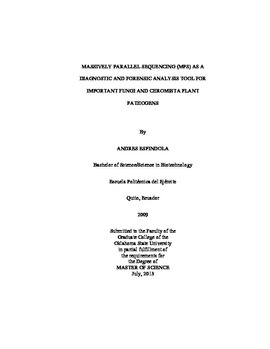| dc.contributor.advisor | Garzon, Carla D. | |
| dc.contributor.author | Espindola, Andres Sebastian | |
| dc.date.accessioned | 2014-09-24T14:18:30Z | |
| dc.date.available | 2014-09-24T14:18:30Z | |
| dc.date.issued | 2013-07-01 | |
| dc.identifier.uri | https://hdl.handle.net/11244/11155 | |
| dc.description.abstract | Different mechanisms are involved in the movement of plant pathogens such as rainwater, wind, vectors, etc. Eukaryotic plant pathogens, and principally fungal and chromista are mostly dispersed by air-, water- or soilborne spores. Early stage infections caused by fungal/oomycete spores may not be detected until signs or symptoms are developed visibly. Although specific and sensitive molecular and serological diagnostic methods have been developed to increase the capability of plant pathogen detection, their scope is limited to a single or a few organisms. In addition, as a part of molecular-based detection methods, sequencing has also being widely utilized as a diagnostic tool, principally Sanger sequencing. Its specificity and sensitivity depends of the targeted locus uniqueness and copy number, and its detection scope is also narrowed to one sample per reaction. The detection sensitivity and specificity of PCR based detection methods is improved when using more than one locus. Massively parallel sequencing (MPS) randomly sequences numerous various DNA fragments from one single DNA sample in parallel. As a result, multiple loci are targeted, and among them, unique signatures of pathogens are highly likely to be identified from the sequencing output. In this study, MPS is proposed as a diagnostic and forensic analysis tool for important fungal and chromista plant pathogens. The pathogens used in this study are Puccinia gramins f. sp. tritici, Phakopsora pachyrhizi (Fungi), Phytophthora ramorum, and Pythium ultimum (Chromista). The first objective was to simulate 454 sequencing runs to standardize optimal e-probe length and statistical analyses for viability of the method. The second objective was to test the diagnostic method using databases created from real infected plant samples. The diagnostic method was successful in the detection of the four pathogens in Mock Sample Sequencing Databases (MSSDs) and in real sequencing data output even at low pathogen abundances. | |
| dc.format | application/pdf | |
| dc.language | en_US | |
| dc.publisher | Oklahoma State University | |
| dc.rights | Copyright is held by the author who has granted the Oklahoma State University Library the non-exclusive right to share this material in its institutional repository. Contact Digital Library Services at lib-dls@okstate.edu or 405-744-9161 for the permission policy on the use, reproduction or distribution of this material. | |
| dc.title | Massively Parallel Sequencing (Mps) As a Diagnostic and Forensic Analysis Tool for Important Fungi and Chromista Plant Pathogens | |
| dc.type | text | |
| dc.contributor.committeeMember | Marek, Stephen | |
| dc.contributor.committeeMember | Hoyt, Peter | |
| osu.filename | Espindola_okstate_0664M_12927.pdf | |
| osu.accesstype | Open Access | |
| dc.description.department | Plant Pathology | |
| dc.type.genre | Thesis | |
| dc.subject.keywords | massively parallel sequencing | |
| dc.subject.keywords | next generation sequencing | |
| dc.subject.keywords | phakopsora pachyrhizi | |
| dc.subject.keywords | phytophthora ramorum | |
| dc.subject.keywords | puccinia graminis | |
| dc.subject.keywords | pythium ultimum | |
